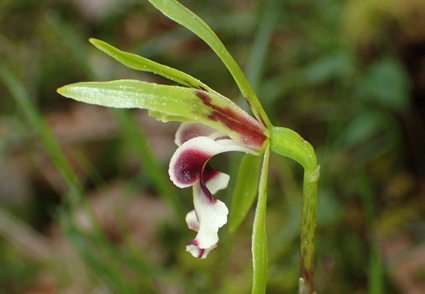Abstract
The Calypsoinae orchid genus Dactylostalix, previously considered a monotypic genus endemic to Japan and the Russian Far East (the Kuril Islands and Sakhalin Island), is now redefined to encompass two species. This reclassification is based not only on the examination of type specimens and literature but also on molecular data. While Pergamena uniflora has long been regarded as a synonym of Dactylostalix ringens, it is distinguishable by its shorter scape, smaller flower, less spotted tepals, drooping sepals and lateral petals, labellum with smaller, narrowly triangular to ovate lateral lobes, more distinct keels on the adaxial surface of the lip, and a slender column with a smaller stigma and weakly developed clinandrium. We propose the new combination Dactylostalix uniflora, recognizing it as a distinct species within the genus Dactylostalix. Phylogenetic analysis utilizing genome-wide markers has also demonstrated that the two species are genetically distinct. Our findings, obtained through the integration of morphological data and molecular phylogenetics, indicate that D. uniflora represents a distinct evolutionary lineage from D. ringens. Examination of type specimens has led us to conclude that Calypso japonica, Dactylostalix maculosa, and Dactylostalix ringens f. punctatus are junior synonyms of D. ringens. Additionally, we designate the lectotypes for P. uniflora (= D. uniflora), C. japonica, and D. maculosa.
References
- Barrett, C.F., Freudenstein, J.V., Taylor, D.L. & Koljalg, U. (2010) Rangewide analysis of fungal associations in the fully mycoheterotrophic Corallorhiza striata complex (Orchidaceae) reveals extreme specificity on ectomycorrhizal Tomentella (Thelephoraceae) across North America. American Journal of Botany 97: 628–643. https://doi.org/10.3732/ajb.0900230
- Chase, M.W., Cameron, K.M., Freudenstein, J.V., Pridgeon, A.M., Salazar, G., Van den Berg, C. & Schuiteman, A. (2015) An updated classification of Orchidaceae. Botanical Journal of the Linnean Society 177: 151–174. https://doi.org/10.1111/boj.12234
- Doyle, J.J. & Doyle, J.L. (1990) Isolation of plant DNA from fresh tissue. Focus 12: 13–15. https://doi.org/10.2307/2419362
- Finet, M.E. (1900) Les orchidées du Japon, principalement d’après les collections de l’Herbier du Muséum d’histoire naturelle de Paris. Bulletin de la Société botanique de France 47: 262–285. https://doi.org/10.1080/00378941.1900.10828922
- Freudenstein, J.V. (1994) Gynostemium structure and relationships of the Corallorhizinae (Orchidaceae: Epidendroideae). Plant Systematics and Evolution 193: 1–19. https://doi.org/10.1007/BF00983537
- Freudenstein, J.V., Garcia-Cruz, J., Grayer, R.J., Pridgeon, A.M. & Veitch, N.C. (2005) Tribe Calypsoeae. In: Pridgeon, A.M., Cribb, P.J., Chase, M.W. & Rasmussen, F.N. (eds.) Genera Orchidacearum: Epidendroideae (Part one). Oxford University Press, New York, USA, pp. 89–115. https://doi.org/10.1093/oso/9780198507123.003.0002
- Freudenstein, J.V., Yukawa, T. & Luo, Y. (2017) A reanalysis of relationships among Calypsoinae (Orchidaceae: Epidendroideae): floral and vegetative evolution and the placement of Yoania. Systematic Botany 42: 17–25. https://doi.org/10.1600/036364417X694944
- Huson, D.H. & Bryant, D. (2006) Application of phylogenetic networks in evolutionary studies. Molecular Biology and Evolution 23: 254–267. https://doi.org/10.1093/molbev/msj030
- Inoue, K. (2016) Dactylostalix. Flora of Japan 4b: 297.
- IUCN (2022) Guidelines for using the IUCN Red List Categories and Criteria. Version 15.1. Prepared by the Standards and Petitions Committee of the IUCN Species Survival Commission. Available from: https://www.iucnredlist.org/documents/RedListGuidelines.pdf (accessed 8 December 2023)
- Komarov, V.L. (1901) Calypso Salisb. Trudy Imperatorskago S.-Peterburgskago botanicheskago sada 20: 532–533.
- Linnaeus, C. (1753) Species plantarum. Laurentius Salvius, Stockholm. 1200 pp.
- Makino, T. (1905) Observations on the flora of Japan. The Botanical Magazine, Tokyo 19: 14. https://doi.org/10.15281/jplantres1887.19.86
- Miyabe, K. & Kudo, Y. (1915) Materials for a flora of Hokkaido. V. Transactions of the Sapporo Natural History Society 6: 1–9.
- Miyabe, K. & Tatewaki, Mi. (1937) Contributions to the flora of northern Japan IX. Transactions of the Sapporo Natural History Society 15: 41–51.
- Oakes, W. (1842) Catalogue of Vermont plants. C. Goodrich. 28 pp.
- Reichenbach, H.G. (1878) Ad orchidographiam Japonicam symbolae. Botanische Zeitung 36: 74–76.
- Rein, J.J. (1881) Japan nach Reisen und Studien. Engelmann, Leipzig. 90 pp.
- Rochette, N.C., Rivera-Colón, A.G. & Catchen, J.M. (2019) Stacks 2: Analytical methods for paired-end sequencing improve RADseq-based population genomics. Molecular Ecology 28: 4737–4754. https://doi.org/10.1111/mec.15253
- Stamatakis, A. (2014) RAxML version 8: a tool for phylogenetic analysis and post-analysis of large phylogenies. Bioinformatics 30: 1312–1313. https://doi.org/10.1093/bioinformatics/btu033
- Suetsugu, K., Haraguchi, T.F., Tanabe, A.S. & Tayasu, I. (2021a) Specialized mycorrhizal association between a partially mycoheterotrophic orchid Oreorchis indica and a Tomentella taxon. Mycorrhiza 31: 243–250. https://doi.org/10.1007/s00572-020-00999-z
- Suetsugu, K., Haraguchi, T.F. & Tayasu, I. (2022) Novel mycorrhizal cheating in a green orchid: Cremastra appendiculata depends on carbon from deadwood through fungal associations. New Phytologist 235: 333–343. https://doi.org/10.1111/nph.17313
- Suetsugu, K., Hirota, S.K. & Suyama, Y. (2021b) First record of Goodyera × tamnaensis (Orchidaceae) from Boso Peninsula, Chiba Prefecture, Japan, based on morphological and molecular data. Taiwania 66: 113–120.
- Suetsugu, K. & Matsubayashi, J. (2021) Subterranean morphology modulates the degree of mycoheterotrophy in a green orchid Calypso bulbosa exploiting wood-decaying fungi. Functional Ecology 35: 2305–2315. https://doi.org/10.1111/1365-2435.13864
- Suyama, Y., Hirota, S.K., Matsuo, A., Tsunamoto, Y., Mitsuyuki, C., Shimura, A. & Okano, K. (2022) Complementary combination of multiplex high-throughput DNA sequencing for molecular phylogeny. Ecological Research 37: 171–181. https://doi.org/10.1111/1440-1703.12270
- Thiers, B. (2023) Index Herbariorum: A Global Directory of Public Herbaria and Associated Staff. New York Botanical Garden’s Virtual Herbarium. Available from: http://sweetgum.nybg.org/science/ih/ (accessed 6 December 2023)
- Yagame, T., Lallemand, F., Selosse, M.-A., Funabiki, E. & Yukawa, T. (2021) Mycobiont diversity and first evidence of mixotrophy associated with Psathyrellaceae fungi in the chlorophyllous orchid Cremastra variabilis. Journal of Plant Research 134: 1213–1224. https://doi.org/10.1007/s10265-021-01337-w
- Yonekura, K. (2011) Taxonomic notes on vascular plants in Japan and its adjacent regions (II). Journal of Japanese Botany 86: 230–241.


